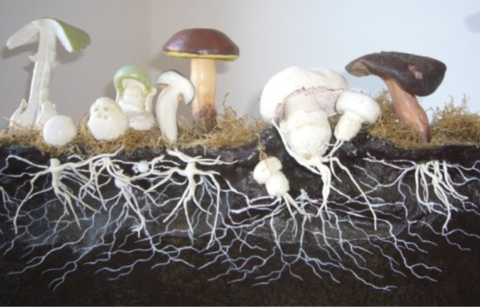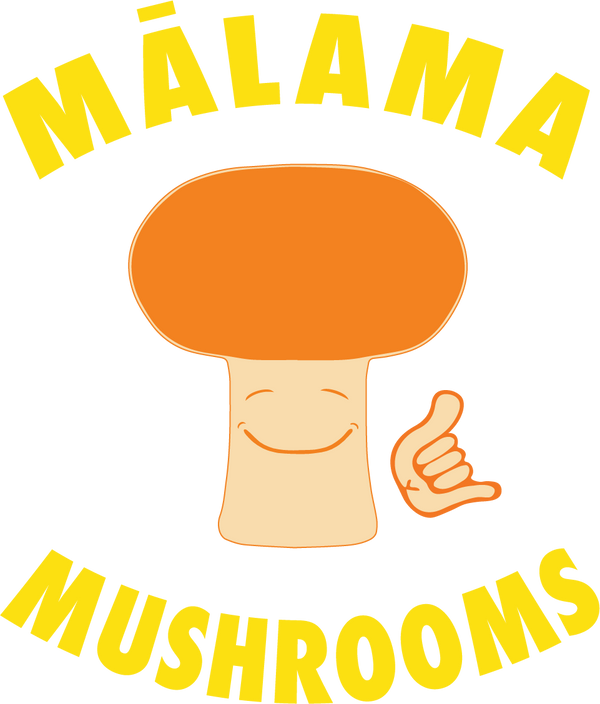
'Mycelium vs Fruiting-Body'
Share
In this blog we cover what exactly ‘mycelium’ & ‘mycelium on grain' is, and why we so vehemently tout our 'fruiting-body' products over it.
What is mycelium?
The mycelium is essentially the white filamentous, root-like structure of the fungi organism. In the wild, it remains mostly out-of-sight, embedded within its host or growing substrate. If you’ve ever lifted a rock in the woods or moved a dead tree and saw the white fibrous material underneath, it is likely you’ve seen mycelium first hand!

Mycelium are akin to the limbs/roots of the mushroom which is the fruit-body
The mycelium can eventually fruit a mushroom(s). The mushroom is the reproductive organ of the fungi and it contains spores (seeds) that can eventually spread & propagate new mycelium growth in new areas. A common analogy that works pretty well is that of an apple tree. The mushroom is akin to the apple and the mycelium is like the limbs & roots of the apple-tree.

The mushroom life-cycle
Still with me? Here is where we get into some controversy.
The Issue
As the amount of time to grow mycelium is obviously shorter than the mushrooms (like the tree comes well before the actual apples). Certain companies have deceptively taken on the practice of stopping the cultivation cycle at the mycelium stage, powderizing it, and selling it as ‘mushrooms’.
This alone is clearly dishonest & disingenuous, but it gets worse. It turns out that this powder is actually even hardly the mycelium as it contains mostly just the substrate it is cultivated on.

A bag of myceliated grain
The cheapest and most common growth-substrate to cultivate fungi on is grains (like rice, or oats) typically on sterilized, brick-like, consolidated blocks. This practice is common & generally okay if one is fruiting them out to mushrooms. However, for these mycelium based companies, they stop short of that.
What's worse is that the mycelium actually cannot fully colonize or digest most of the grains (some estimating as low as 30-40%). Thus, as much of 60-70% of this mycelium-block is actually still the inert grain. The mycelium-block is then dried, powderized, and sold/ marketed as mushrooms.
Even a patent of Paul Stamets, whos product Host Defense contains primarily myceliated products, even discloses that mycelium will only colonize 30-40%. (Scroll down about 75% and see Example 9)

A product touting "mushrooms" but only mycelium on grain
‘Full Spectrum": The New Deception
Adding to the deception and confusion of the customer is that some of these mycelium on grain companies have caught-wind of consumer education shedding light on the controversy of ‘mycelium on grain’. Thus, an effort has begun to slip in slight amounts of fruit-body into the blend so they put it on the Supplement Fact panel on the back of these products. They then claim these products are thus "Full Spectrum", containing both fruiting-body & mycelium. However, the reality is they are majority myceliated grain powder.

A mycelium on grain product that disingenuine touts 'fruit body'
I know as I was greatly deceived and was actually going to partner with one of these companies and source from their farm when I first began Mālama Mushrooms. I had purchased multiple kilograms of powdered product and was getting ready to launch until last minute I requested a picture of the ‘fruit-body’. that I was shown the picture below.

Actual picture of "fruit body" sent to me from supplier I almost partnered with that also supplies the brand of the picture above this one
As you can see, there is nothing that even closely resembles a fruit-body in this picture. When I inquired about this, they pointed to the tiny ‘primordia’ (tiny organic tissue in the earliest stage of development). With some mushrooms taking weeks, even months, to fruit, the difference in maturity of not just the physical state, but also the biochemical makeup, and thus potential therapeutic benefits, of a mushroom between its primordia & fully-mature stage is orders of magnitudes of disparity.

A Reishi fruiting-body. How could this possibly create such a light powder as is the case of the brands product on the left below.
Don’t get me wrong, the mycelium is a fascinating part of the fungi, and one that we are still learning much about. I 100% acknowledge it likely contains useful metabolites and chemicals and, in some cases, it may even produce compounds that the fruiting-body doesn’t. However, the literature overwhelmingly points the other way of the fruiting-body producing compounds the mycelium doesn’t…not to mention most of the studies mushrooms benefits on humans is done with fruiting-bodies. But again, at its core this isn’t as much a question of ‘mycelium vs. fruiting-body’ as it is of a completely compromised product that is mostly grain.

Left: Their Reishi mycelium and 'fruit body' powder
Right: Our Reishi fruit body powder
At the end of the day, one may not need to rely on the informational panel to decipher the quality of their favorite brands product (aside from saving themselves the initial investment). Solely looking at the final product can tell you tons. Take the two Reishi powder products above. One brand is on the left and is a light colored starchy powder (crazy considering how dark & red the Reishi is!) and if you could taste it, you could taste a very oat-like flavor. On the right is ours, a dark, robust, bitter (as Reishi should taste) full-flavored powder. This is because we use 100% fruiting-bodies in all of our mushroom products. No grains, no fillers, just the real deal. We even have them steamed for several hours to make it more bioavailable.

3 comments
THANK YOU FOR SENDING THIS INFORMATION , I REALLY APPRECIATE IT OUR 8 BLEND WILL BE HERE TODAY , I AM ANXIOUS TO TRY IT
Hi,
I’m not totally sure the information presented here is fully accurate. According to Stamet’s team, the substrate is highly bioactive and not just filler. https://hostdefense.com/blogs/host-defense-blog/mycelium-explained
I would like to know more about this. Are there other peer reviewed studies you can point people to?
Thank you.
Wow this is such good information! I would have never known about the differences between mycelium and fruiting body, or how to watch out for dodgy mush products. Thank you for helping me be an informed consumer.